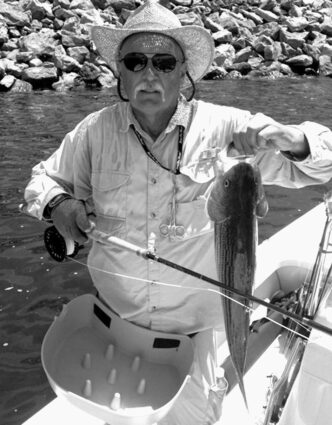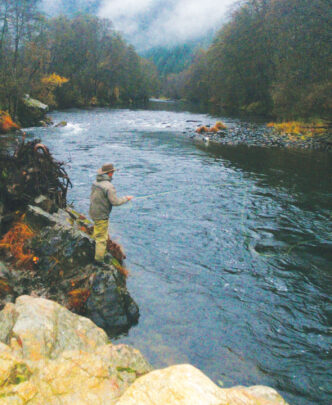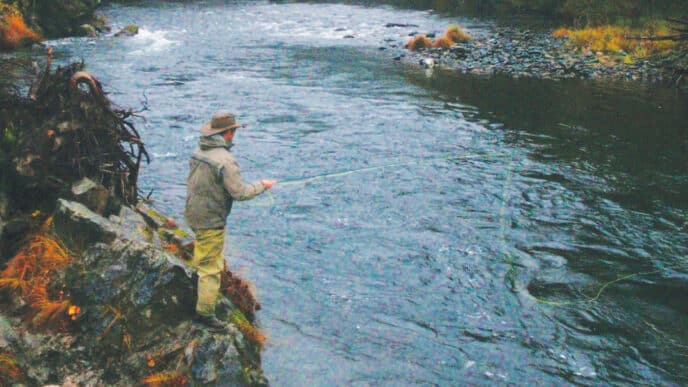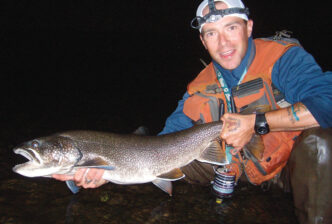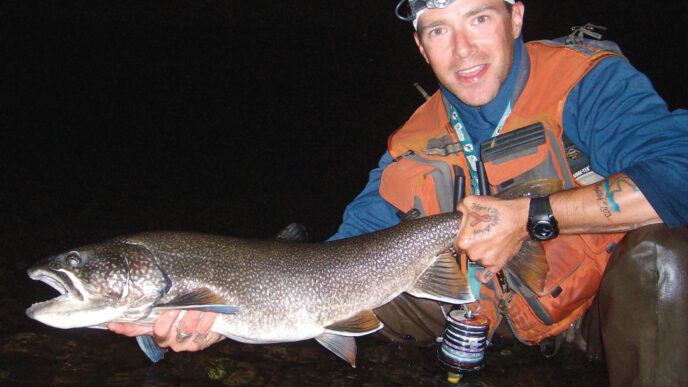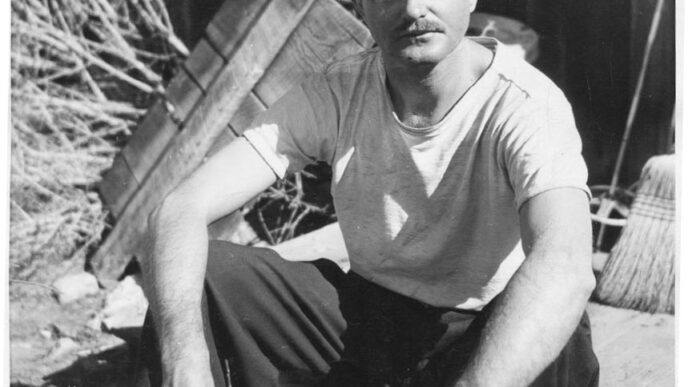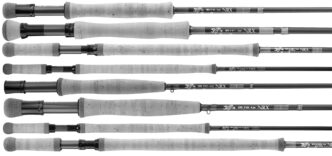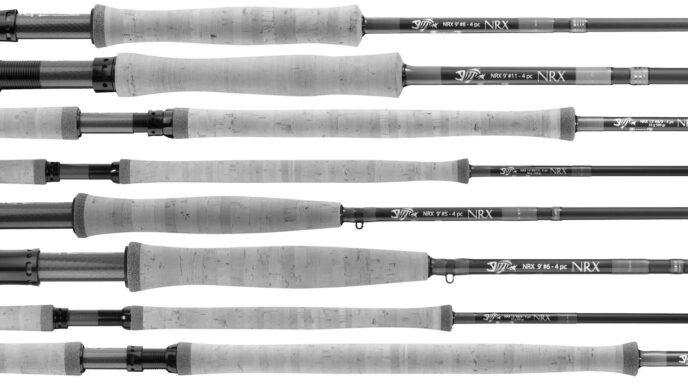We’re now into the season when cold fronts begin to blow across the state, and these fronts can trigger aggressive feeding by striped bass, one of the great game fish in California, which are found in the surf along much of the Northern California coast and in fresh water in the Sacramento Delta, in the Colorado River, and in a number of reservoirs. Late autumn and early winter can produce spectacular angling as big stripers move out of the depths and into the shallows to chase smaller fish (often, planted trout). On lakes where a summer outing with a fly rod might net a few small schoolie stripers, a cold, blustery day with overcast skies and a bit of wind on the water can help a lucky angler bring to hand potbellied striped bass measured in multiple pounds. These fish become especially vulnerable to a streamer cast or trolled in the upper few feet of water.
Gear for striped bass varies widely with the situation. If you are new to fishing for striped bass, you might first want to look around for a rod capable of throwing fast-sinking lines and battling big fish that may weigh in the double-digit range. At the upper end of this class of rods are the 9-weights and 10-weights often used for very large salmon or saltwater angling, where you might find yourself casting to stripers in the surf on windy days and need the power that these big rods provide. On the other hand, I know at least one guide who catches a lot of striped bass every year and almost never fishes anything heavier than a 6-weight rod. You might as well split the difference and start with something in the 7-weight or 8-weight category.
Even a 10-weight rod is going to be stressed if you happen on a really big striped bass. Stripers weighing in the range of 60 to 70 pounds have been caught on portions of the Colorado River, and fish in the 30-pound range are not uncommon around the Willow Beach area of Lake Mohave. In fact, striped bass of 20 to 30 pounds can show up along most of the Colorado from Lake Powell to Mexico. Fish this heavy can also be found in the Delta, San Luis Reservoir, and O’Neill Forebay, down the length of the California Aqueduct, and in almost any reservoir in Southern California that has stripers. Recent catches of stripers in Diamond Valley Reservoir in Riverside County show that the size of the fish there is going up quickly, and this will probably be the quality striped bass water of the near future in the southern half of the state.
Vince Novits, a member of the Deep Creek Fly Fishers, has geared up for striped bass at Diamond Valley with a 13-foot Spey rod. He and some buddies spent time in the late summer and early fall this year fishing for reservoir stripers that came up swiftly, boiled on threadfin shad at the surface, then disappeared just as suddenly into the cooler depths. Vince told me that he really likes the Spey rod for the long casts he sometimes has to make when fishing these bait boils.
“I made probably a 60-foot cast, then made two strips of the line, and he was on,” said Vince. “My rod is a 7/8-weight, and it took me about 10 minutes to land that fish. The guys who are fishing down 50 to 60 feet are catching bigger stripers, but fishing boils is fun.”
Although I emphasize that you need a rugged fly rod, I don’t necessarily equate that with an expensive one. Some of the older (and some newer) rods of fiberglass have a nice, slightly slow action that makes them ideal for casting big, wind-resistant streamers and poppers.
You need to combine that heavier rod with a quality reel and at least two lines. First, you need a floating weight-forward line capable of handling large streamers and the occasional pencil popper in the 1/0 to 4/0 size range. You also need a fast-sinking line designed to let you fish down anywhere from just below the surface to as deep as you can get — meaning 15 to 20 feet in some lakes.
Floating lines for delivering saltwater-sized pencil poppers or large streamers are now fairly standard equipment. You can just go with a so-called bassbug taper or choose any one of many designs for use in saltwater fishing. There also are fly lines designated as striper lines. They will all cast big flies reasonably well. Those designed to retain their flex in colder water, so-called “low-memory” lines, come in handy in really cold conditions.
The sinking line you choose is up to you, but why fool around? Go for the fastest-sinking line you can find. I often fish a Type VI line that sinks line a stone, saving me countdown time when trying to get really deep and allowing me to start the retrieve a lot more quickly at moderate depths. These lines head for the bottom like a lead-core shooting head in the hands of a old-time steelheader, but are infinitely more reasonable to cast. Personally, I have come to like a full-length sinking line, rather than a sinking shooting head, even though I’ll admit that by using a reel equipped with a slender running line and a group of sinking shooting heads, the angler can quickly adapt to almost any depth or condition. I just find that the full-length lines cast more easily.
Leaders in almost all cases needn’t be fancy. I often just tie on a length of straight mono or fluorocarbon anywhere from 6-pound to 10-pound test for most of my striper fishing — and if I were fishing where real monsters roam, I might go as heavy as 20-pound test. There’s nothing particularly delicate about casting stripersized flies, and a tapered leader often isn’t needed. As long as the fly gets where it’s going, whatever you use is fine. On floating lines, though, I may create a leader with a butt section that matches the fly line reasonably well and tie in a tippet of one of the weights just mentioned.
Flies for striped bass have several things in common. For the most part, they are larger than you would fish for trout or even bass. Streamers tied on 2/0 to 4/0 hooks are not unusual. Generally speaking, there are just two categories: poppers for the surface and streamers for subsurface presentations. At all times you are imitating baitfish. In my neck of the woods, the primary forage fish for stripers is either threadfin shad, which can be imitated on a hook from size 4 up to around 1/0, or hatchery-supplied rainbow trout, which are too large to replicate with a fly that you can cast decently.
Actually, stripers eat just about any fish they can catch. I’ve seen them chasing shad and trout, but I’ve also seen them scooping up baby bluegills, small bass and crappies, and carp of many sizes. Big stripers will eat little stripers, as well. One of the things that most of these smaller fish have in common is that they usually have silvery or white bodies (except for carp). Effective flies for striped bass tend to have a lot of white in them.
A Clouser Minnow is a pretty fair shad imitation. So is a Lefty’s Deceiver. I have come to like fishing an offshoot of the Clouser that has a single Colorado spinner blade on a swivel under the nose. It’s called the Coyote and was developed by a Southern striper angler for use in stained or dingy water. The Deceiver can be tied from a two-inch-long mini version up to a six-to-eight-inch saltwater version. If you have or can obtain a copy of Saltwater Fly Patterns by Lefty Kreh, you can find multiple versions of this fly, along with ties for Dan Blanton’s famous Whistler pattern, which is another excellent striped bass fly. In Southern California, the BS fly, a shad imitation that is simple, yet effective, has accounted for literally thousands of striped bass. Named after guide Bob Slamal, it is a rebuild of a Jay Fair trolling fly, and while it doesn’t have a big collar to push water like the Whistler, or prominent eyes, like most other striper patterns do, it catches fish. I’ve fished the BS fly all over Southern California, for both stripers and largemouth bass, and have caught a bunch of fish on it — including some nice trout. I suspect it would be a great fly for big browns anyplace where there are shad or other silvery baitfish.
Bob recently caught a large striper at Diamond Valley while casting instead of trolling or “dragging” an all-white BS fly on a combination of sinking line and leadcore shooting head. The fish were probably at least 50 feet down, although they will start to enter much shallower water and for longer periods as surface temperatures cool in the early winter.
I have talked to anglers who have scored well on stripers using big flies intended for pike and muskies. I spoke at length to a fellow from New Mexico who fished for big stripers on a couple of giant reservoirs there, and he insisted that a big Bunny fly with a prop on it tied in garish reds and yellows worked well. He did note that the water was slightly discolored most of the time, and that may be the reason why the bright colors worked.
For the surface, a cork, foam, or balsa pencil popper or skipping bug is ideal. As with the streamer patterns, white is a good base color. I’ve caught a few stripers on black poppers, but will usually settle for all white or red and white for my fishing. Solid silver also works, and I’ve used a fair number of smaller foam pencil poppers that are covered in silver foil to replicate the flash of a silversides or shad.
When striped bass boil, hitting bait on or near the surface, you can see the violent result for quite a distance. On larger waters, such as Lake Havasu or Diamond Valley, a pair of binoculars is as much a necessary piece of your fishing equipment as a fly rod. Just as you would do while fishing the ocean, look for birds working the bait from above.
Even when they are in the midst of slaughtering baitfish in a boil, stripers can be spooky. You can’t go charging right into the boil with the big motor on your boat running, or you’ll simply put the boil down. Instead, cut the gas engine a little early and either coast in or get on the electric trolling motor to move within casting range. When there’s an active boil, the proper retrieve for a popper or streamer fished on the surface is as fast as you can. If you’ve fished for bonito or yellowtail, you know the drill. Some anglers put the rod between their legs or under an arm and strip with both hands to make the popper fly across the surface like a scared baitfish. I’ve never had to move the fly that quickly to get stripers to bite, but I’ve heard of occasions when it worked.
When there’s no surface action, striper fishing becomes either casting to submerged points or simply dragging a streamer fly on a sinking line until you get a strike. Knowledgeable anglers constantly strip and release line while slow trolling to make the streamer dart ahead, then pause. This mimics a baitfish better than a steady crawl, and the quick dart triggers aggressive behavior from the striper that sees it. Fly fishing for striped bass on most of our reservoirs isn’t particularly complicated, and you can mostly get away with your heavier trout tackle. It will either be boom or bust. If they are chasing bait on or near the surface, the action is rapid and exciting. If they aren’t, it is a grind, but either way, it’s better than staying home.



